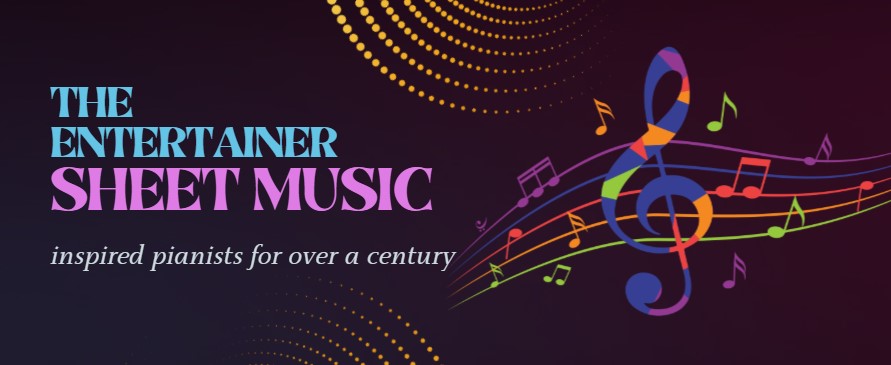The Timeless Charm of The Entertainer Sheet Music
Few compositions in the history of piano music have captured the imagination of audiences like The Entertainer. Written by Scott Joplin in 1902, this piece quickly became a staple in the ragtime era. The Entertainer sheet music has inspired pianists for over a century, offering a blend of rhythmic sophistication and melodic simplicity. Its catchy syncopation, playful character, and bright harmonies make it a joy to perform for musicians at every skill level.
From beginner enthusiasts to seasoned concert pianists, the entertainer sheet music continues to serve as a gateway into the fascinating music. It connects the past with the present, allowing players to experience the same joy listeners felt when Joplin’s notes first rang out.
Historical Roots of Ragtime Brilliance
The Entertainer sheet music is a product of the golden age of ragtime, a musical style born in African American communities. Ragtime was characterized by its syncopated rhythms, a style that set it apart from the more formal European piano traditions.
Scott Joplin, often referred to as the “King of Ragtime,” crafted The Entertainer to highlight the style’s energetic nature while retaining elegance. The Entertainer sheet music preserves this duality—playfulness paired with refinement—making it one of the most enduring pieces from the era. Pianists who study it not only learn a composition but also absorb a part of American musical heritage.
Structure and Musical Patterns of The Entertainer Sheet Music
One of the most fascinating aspects of the entertainer sheet music lies in its structure. Each section brings fresh motifs, yet they remain connected through rhythmic consistency and harmonic flow.
The left hand maintains a steady, march-like bass pattern, while the right hand delivers syncopated melodies that seem to dance above it. This interplay between stability and surprise is what gives the entertainer’s sheet music its distinct character. Musicians find it both a challenge and a delight, as it demands precise timing and a keen sense of rhythm.
Also read: the Web Extreme Entertainment
Why Pianists Gravitate Towards It
For many learners, the entertainer sheet music is a rite of passage. Its moderate tempo makes it approachable, while its rhythmic complexity ensures that players develop coordination skills. Beginners appreciate the straightforward patterns in the bass, while advanced musicians enjoy adding stylistic flourishes, such as rolled chords and subtle rubato.
Beyond technique, the entertainer sheet music offers emotional engagement. Each section tells a musical story, shifting from buoyant joy to reflective charm. Pianists often describe the satisfaction of mastering its syncopation as both technically rewarding and personally fulfilling.
Learning and Practice Tips
Approaching the entertainer sheet music requires patience and attention to detail. Start with slow practice, ensuring that each syncopated note is placed accurately against the steady left-hand accompaniment. Breaking the piece into small sections helps with memorization and reduces the feeling of being overwhelmed.
Another key to mastering the entertainer sheet music is to listen to multiple interpretations. It’s also beneficial to practice hands separately before combining them, as this reinforces rhythmic independence.
Modern Appeal and Cultural Impact of The Entertainer Sheet Music
Even though it was composed over a century ago, the entertainer sheet music enjoys ongoing popularity in films, commercials, and television. This exposure introduced ragtime to a new generation, making The Entertainer one of the most recognized piano tunes in the world.
The entertainer sheet music thus bridges generations. Older audiences cherish it for nostalgia, while younger listeners embrace its joyful, upbeat style. Its adaptability ensures that it remains relevant, whether performed on a grand piano in a concert hall or played casually on a digital keyboard at home.
Preserving the Legacy of The Entertainer Sheet Music
Owning a copy of the entertainer sheet music is like holding a piece of musical history. It serves as both a learning tool and a collector’s item for those passionate about ragtime. Teachers continue to recommend it to students, knowing that it builds technical skills while nurturing a love for expressive piano music.
As the digital age makes music more accessible, the entertainer sheet music is available in various arrangements—simplified versions for beginners, authentic scores for purists, and creative adaptations for other instruments. This flexibility guarantees that Scott Joplin’s masterpiece will endure, inspiring pianists for decades to come.
Exploring Different Arrangements of The Entertainer Sheet Music
One of the reasons the entertainer sheet music has remained popular is the wide variety of arrangements available. For beginners, simplified versions reduce the complexity of syncopated rhythms, allowing them to grasp the essence of the piece without feeling overwhelmed. Intermediate players might choose arrangements that preserve most of Joplin’s original details while offering manageable technical demands. Advanced pianists often prefer the authentic score, complete with all the rhythmic intricacies and dynamic markings that make the music sparkle.
Arrangements also extend beyond the piano. Violin, guitar, accordion, and even full orchestral versions exist, each offering a fresh take on the original composition. These adaptations showcase the versatility of the entertainer sheet music, proving that great melodies can thrive in countless musical settings. The enduring appeal of these variations keeps the piece in active circulation among musicians of all kinds.
The Joy of Performance of The Entertainer Sheet Music
Performing the entertainer sheet music is an experience unlike any other. Its playful yet refined energy naturally engages audiences, often drawing smiles and applause. Pianists relish the challenge of balancing precision with expression, ensuring the syncopation remains crisp while the melody flows effortlessly.
Public performances of this piece often feel timeless. Whether played in a concert hall, a community event, or even at a casual gathering. The entertainer sheet music encourages interaction—foot tapping, nodding to the rhythm, and even nostalgic storytelling from those familiar with its history. In this way, each performance becomes more than just a musical act; it’s a shared moment that bridges generations.

